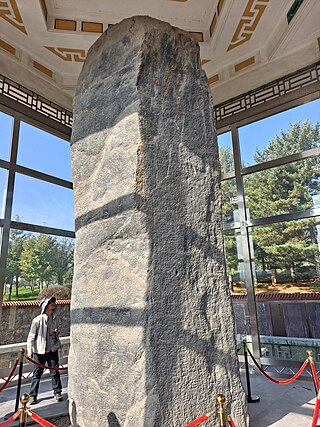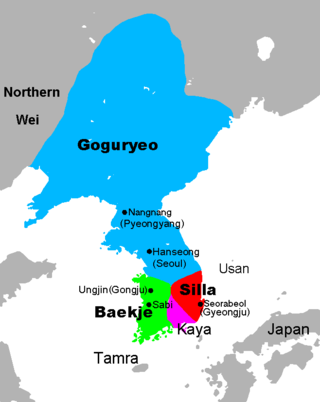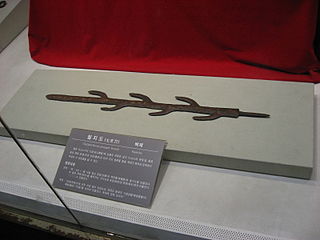
Goguryeo also later known as Goryeo, was a Korean kingdom which was located on the northern and central parts of the Korean Peninsula and the southern and central parts of modern-day Northeast China (Manchuria). At its peak of power, Goguryeo conquered most of the Korean Peninsula and large parts of Manchuria, along with parts of eastern Mongolia, Inner Mongolia, and modern-day Russia.

Baekje or Paekche was a Korean kingdom located in southwestern Korea from 18 BC to 660 AD. It was one of the Three Kingdoms of Korea, together with Goguryeo and Silla. While the three kingdoms were in separate existence, Baekje had the highest population of approximately 3,800,000 people, which was similar to that of Goguryeo and much larger than that of Silla.
The five kings of Wa were kings of ancient Japan who sent envoys to China during the 5th century to strengthen the legitimacy of their claims to power by gaining the recognition of a Chinese emperor during the chaotic period of the Northern and Southern dynasties, when either dynasty was desperate to gain legitimacy over the other by trying to assert itself as the granter of official titles, through garnering as many foreign countries willing to receive titles.

The Three Kingdoms of Korea or Samguk competed for hegemony over the Korean Peninsula during the ancient period of Korean history. During the Three Kingdoms period, many states and statelets consolidated until, after Buyeo was annexed in 494 and Gaya was annexed in 562, only three remained on the Korean Peninsula: Goguryeo, Baekje and Silla. The "Korean Three Kingdoms" contributed to what would become Korea; and the Goguryeo, Baekje and Silla peoples became the Korean people.

Empress Jingū was a legendary Japanese empress who ruled as a regent following her husband's death in 200 AD. Both the Kojiki and the Nihon Shoki record events that took place during Jingū's alleged lifetime. Legends say that after seeking revenge on the people who murdered her husband, she then turned her attention to a "promised land". Jingū is thus considered to be a controversial monarch by historians in terms of her alleged invasion of the Korean Peninsula. This was in turn possibly used as justification for imperial expansion during the Meiji period. The records state that Jingū gave birth to a baby boy whom she named Homutawake three years after he was conceived by her late husband.
Sabi was the third and final capital of the Korean kingdom of Baekje, from 538 until Baekje’s fall in 660 CE. The site of Sabi is located in modern-day Buyeo County, South Chungcheong Province, in South Korea.

Gwanggaeto the Great was the nineteenth monarch of Goguryeo. His full posthumous name means "Entombed in Gukgangsang, Broad Expander of Domain, Peacemaker, Supreme King", sometimes abbreviated to Hotaewang. His era name is Yeongnak and he is occasionally recorded as Yeongnak Taewang. Gwanggaeto's imperial reign title meant that Goguryeo was on equal standing as an empire with the imperial dynasties in China.

The Goguryeo language, or Koguryoan, was the language of the ancient kingdom of Goguryeo, one of the Three Kingdoms of Korea. Early Chinese histories state that the language was similar to those of Buyeo, Okjeo and Ye. Lee Ki-Moon grouped these four as the Puyŏ languages. The histories also stated that these languages were different from those of the Yilou and Mohe. All of these languages are unattested except for Goguryeo, for which evidence is limited and controversial.
Buyeo Pung was a prince of Baekje, one of the Three Kingdoms of Korea. He was son of the last king, Uija of Baekje. When Baekje fell to the Silla–Tang alliance in 660, he was a hostage who mortgaged the alliance of Baekje with Japan. He was shortly unofficially proclaimed king.

Wa is the oldest attested name of Japan. From c. the 2nd century AD Chinese and Korean scribes regularly used the Chinese character 倭; 'submissive'', 'distant'', 'dwarf' to refer to the inhabitants of the Wa kingdoms on Kyushu and those of the ancient Yamato kingdom. In the 8th century, the Japanese replaced the character with 和, wa, 'harmony', 'peace', 'balance'.

Jangsu of Goguryeo was the 20th monarch of Goguryeo, the northernmost of the Three Kingdoms of Korea. He was born in 394 as the eldest son of Gwanggaeto. He became the crown prince in 408, and upon his father's death in 413, became the ruler at the age of 19.

Korea's military history spans thousands of years, beginning with the ancient nation of Gojoseon and continuing into the present day with the countries of North Korea and South Korea, and is notable for its many successful triumphs over invaders.
Munja of Goguryeo or Munjamyeong of Goguryeo was the 21st monarch of Goguryeo, the northernmost of the Three Kingdoms of Korea. He was the grandson of Taewang Jangsu (413–491). Though Munja's father Gochudaega Joda had been named Crown Prince by Taewang Jangsu, Joda died before assuming the throne. He is considered as a ruler of Goguryeo at its zenith from Gwanggaeto the Great.

The Seven-Branched Sword is a ceremonial sword believed to be a gift from the king of Baekje to a Yamato ruler. It is mentioned in the Nihon Shoki in the fifty-second year of the reign of the semi-mythical Empress Jingū. It is a 74.9 cm (29.5 in) long iron sword with six branch-like protrusions along the central blade. The original sword has been conserved since antiquity in the Isonokami Shrine in Nara Prefecture, Japan and is not on public display. An inscription on the side of the blade is an important source for understanding the relationships between kingdoms of the Korean peninsula and Japan in that period.

Naemul of Silla was the 17th ruler of the Korean kingdom of Silla. He was the nephew of King Michu. He married Michu's daughter, Lady Boban. He is given the title Isageum, the same one borne by earlier rulers, in the Samguk Sagi; he is given the title Maripgan, borne by later rulers, in the Samguk Yusa. He is the first to bear the title Maripgan in any record.
Gogugyang of Goguryeo was the 18th ruler of Goguryeo, the northernmost of the Three Kingdoms of Korea. During his reign, the balance of power among the Three Kingdoms began to shift, as Goguryeo attacked Baekje, and allied with Silla.

The military history of Goguryeo involves wars with other Korean kingdoms, Chinese dynasties, nomadic states and tribes, and Wa Japan. Goguryeo was a highly militaristic state; it was a powerful empire and one of the great powers in East Asia, until it was defeated by a Silla–Tang alliance in 668 after prolonged exhaustion and internal strife caused by the death of Yeon Gaesomun.

The Goguryeo–Wa War occurred at the end of the 4th century and the beginning of the 5th century between Goguryeo and the Baekje–Wa alliance. As a result, Goguryeo made both Silla and Baekje its subjects, bringing about a unification of the Three Kingdoms of Korea that lasted about 50 years.

The Puyŏ or Puyo-Koguryoic languages are four languages of northern Korea and eastern Manchuria mentioned in ancient Chinese sources. The languages of Buyeo, Goguryeo, Dongye and Okjeo were said to be similar to one another but different from the language of the Yilou to the north . Other sources suggest that the ruling class of Baekje may have spoken a Puyŏ language.

The Wajinden are passages in the 30th fascicle of the Chinese history chronicle Records of the Three Kingdoms that talk about the Wa people, who would later be known as the Japanese people. It describes the mores, geography, and other aspects of the Wa, the people and inhabitants of the Japanese archipelago at the time. The Records of the Three Kingdoms was written by Chen Shou of the Western Jin dynasty at the end of the 3rd century.
















